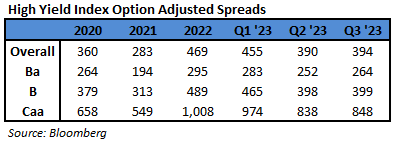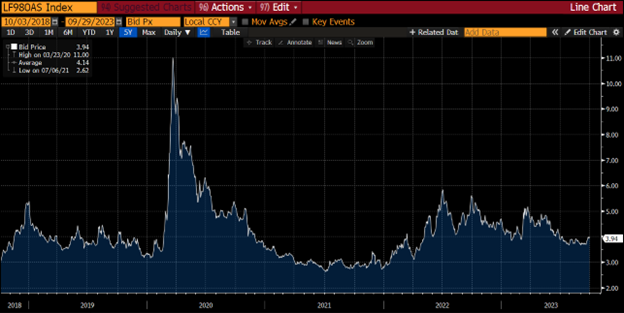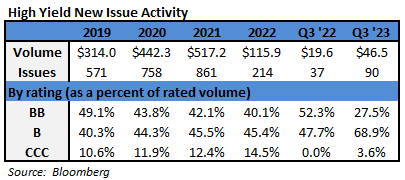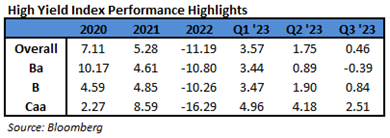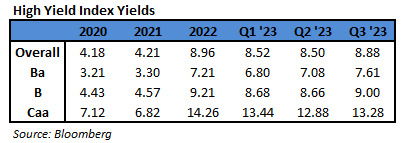2023 Q3 High Yield Quarterly
In the third quarter of 2023, the Bloomberg US Corporate High Yield Index (“Index”) return was 0.46% bringing the year to date (“YTD”) return to 5.86%. The S&P 500 index return was -3.27% (including dividends reinvested) bringing the YTD return to 13.06%. Over the period, while the 10 year Treasury yield increased 73 basis points, the Index option adjusted spread (“OAS”) widened 4 basis points moving from 390 basis points to 394 basis points.
All ratings segments of the High Yield Market participated in the spread widening as BB rated securities widened 12 basis points, B rated securities widened 1 basis point, and CCC rated securities widened 10 basis points. The chart below from Bloomberg displays the spread moves in the Index over the past five years. For reference, the average level over that time period was 414 basis points.
The sector and industry returns in this paragraph are all Index return numbers. The Index is mapped in a manner where the “sector” is broader with the more specific “industry” beneath it. For example, Energy is a “sector” and the “industries” within the Energy sector include independent energy, integrated energy, midstream, oil field services, and refining. The Banking, Brokerage, and Other Financial sectors were the best performers during the quarter, posting returns of 3.18%, 2.56%, and 1.96%, respectively. On the other hand, Electric Utilities, Transportation, and REITs were the worst performing sectors, posting returns of -0.97%, -0.69%, and -0.46%, respectively. At the industry level, oil field services, cable, and independent energy all posted the best returns. The oil field services industry posted the highest return of 3.40%. The lowest performing industries during the quarter were office REITs, healthcare REITs, and health insurance. The office REITs industry posted the lowest return of -5.32%.
While there was a dearth of issuance during 2022 as interest rates rapidly increased and capital structures were previously refinanced, the primary market perked up a bit during each quarter this year. Issuance has remained low by historical standards as so much was pushed out by the large issuance during 2020 and 2021. Of the issuance that did take place during Q3, Energy took 21% of the market share followed by Discretionary at 17% share and Healthcare at a 12% share.
The Federal Reserve did lift the Target Rate by 0.25% at the July meeting but took a pause at the September meeting. There was no meeting held in August. This was the second rate pause, the first being June of this year, during the current 525 basis points hiking cycle that began in March of 2022. A few of the main takeaways from the September meeting and press conference: inflation is still too high, the job market is still too tight, the Fed is just about done with the rate hikes, the Fed remains data dependent but expects rates to stay higher for longer. “We’re fairly close, we think, to where we need to get,” Chair Powell said. “We are committed to achieving and sustaining a stance of monetary policy that is sufficiently restrictive to bring inflation down to our 2% goal over time,” Powell said at a press conference following the decision.i Inflation gauges are certainly off their peaks and moving in the proper direction. The most recent report for Core CPI showed a year over year growth rate of 4.3% down from a peak of 6.6% one year ago. Further, the most recent Core PCE growth rate measured 3.9% off the peak of 5.6% from February of 2022.
Intermediate Treasuries increased 73 basis points over the quarter, as the 10-year Treasury yield was at 3.84% on June 30th, and 4.57% at the end of the third quarter. The 5-year Treasury increased 45 basis points over the quarter, moving from 4.16% on June 30th, to 4.61% at the end of the third quarter. Intermediate term yields more often reflect GDP and expectations for future economic growth and inflation rather than actions taken by the FOMC to adjust the target rate. The revised second quarter GDP print was 2.1% (quarter over quarter annualized rate). Looking forward, the current consensus view of economists suggests a GDP for 2023 around 2.1% with inflation expectations around 4.1%.ii
Being a more conservative asset manager, Cincinnati Asset Management does not buy CCC and lower rated securities. Additionally, our interest rate agnostic philosophy keeps us generally positioned in the five to ten year maturity timeframe. During Q3, Index performance was once again tilted toward the lowest rated end of the market. Further, Index performance was heavily tilted toward short duration as all duration buckets over a three year duration underperformed. Our credit selections within the consumer sectors and aerospace/defense were also a drag to performance. Benefiting our performance this quarter were our overweights in banking and energy, and our credit selections in airlines and independent energy.
The Bloomberg US Corporate High Yield Index ended the third quarter with a yield of 8.88%. Treasury volatility, as measured by the Merrill Lynch Option Volatility Estimate (“MOVE” Index), has picked up quite a bit the past couple of years. The MOVE has averaged 121 during 2023 relative to a 62 average over 2021. However, the current rate of 113 is well below the spike near 200 back in March during the banking scare. Data available through August shows 33 defaults during 2023 which is up from 16 defaults during all of 2022. The trailing twelve month dollar-weighted default rate is 1.86%.iii The current default rate is relative to the 1.10%, 1.14%, 1.30%, 1.74% default rates from the previous four quarter end data points listed oldest to most recent. While defaults are ticking up, the fundamentals of high yield companies still look good. From a technical view, fund flows were negative in the quarter at -$1.8 billion and total -$27.9 billion YTD.iv No doubt there are risks, but we are of the belief that for clients that have an investment horizon over a complete market cycle, high yield deserves to be considered as part of the portfolio allocation.
The data dependent Fed will continue to remain a large part of the story as 2023 works its way toward year end. The data will in fact continue to flow as Congress averted a government shutdown with a last minute agreement. Had the shutdown taken place, some of the data the Fed looks to would not have been available. In reality, Congress just kicked the can down the road to buy less than two months of additional time to work on a more substantial funding package. Adding to the current wall of worry are 10 year rates that are at 15 year highs, oil has ripped higher by $20 per barrel over the past three months, and cracks are seemingly starting to show for the US Consumer. Credit card delinquencies are at the highest level in more than a decade, and a recent report from Moody’s stated, “consumer debt quality is declining.” Our exercise of discipline and credit selectivity is important as we continue to evaluate that the given compensation for the perceived level of risk remains appropriate. As always, we will continue our search for value and adjust positions as we uncover compelling situations. Finally, we are very grateful for the trust placed in our team to manage your capital.
This information is intended solely to report on investment strategies identified by Cincinnati Asset Management. Opinions and estimates offered constitute our judgment and are subject to change without notice, as are statements of financial market trends, which are based on current market conditions. This material is not intended as an offer or solicitation to buy, hold or sell any financial instrument. Fixed income securities may be sensitive to prevailing interest rates. When rates rise the value generally declines. Past performance is not a guarantee of future results. Gross of advisory fee performance does not reflect the deduction of investment advisory fees. Our advisory fees are disclosed in Form ADV Part 2A. Accounts managed through brokerage firm programs usually will include additional fees. Returns are calculated monthly in U.S. dollars and include reinvestment of dividends and interest. The index is unmanaged and does not take into account fees, expenses, and transaction costs. It is shown for comparative purposes and is based on information generally available to the public from sources believed to be reliable. No representation is made to its accuracy or completeness. Additional disclosures on the material risks and potential benefits of investing in corporate bonds are available on our website: https://www.cambonds.com/disclosure-statements/.
i Bloomberg September 20, 2023: Fed Leaves Rates Unchanged
ii Bloomberg October 2, 2023: Economic Forecasts (ECFC)
iii Moody’s September 15, 2023: August 2023 Default Report and data file
iv CreditSights September 28, 2023: “Credit Flows”
